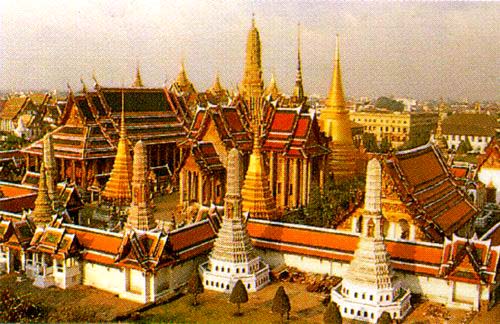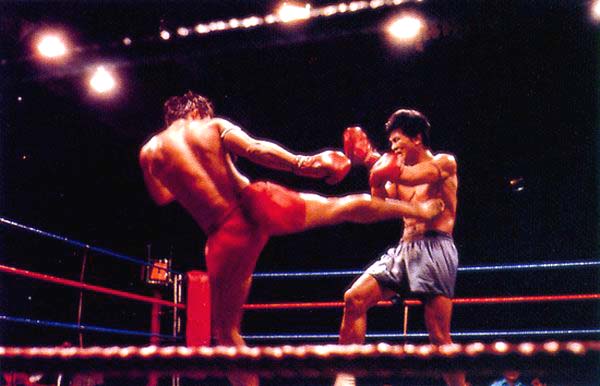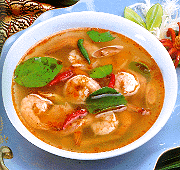 |
WELCOME
to THAILAND The Land of Smile |
 |
 |
WELCOME
to THAILAND The Land of Smile |
 |
Siam
is the name by which the country was known to the world until 1939 and
again between 1945 and 1949. On May 11, 1949, an official proclamation
changed the name of the country to "Prathet Thai", or "Thailand",
by which it has since been known. The word "Thai" means "free",
and therefore "Thailand" means "Land of the Free."
 |
The Kingdom of Thailand, located in Southeast Asia on the Gulf of Thailand and the Andaman Sea, shares boundaries with Myanmar (Burma) on the west and northwest, Laos on the east and northeast, Cambodia (Kampuchea) on the southeast, and Malaysia on the south. Thailand, although rich in rubber and in mineral resources, was never colonized by Europeans and has existed as a unified monarchy since 1350. The capital, BANGKOK, an attractive blend of Western and Thai architecture, was established in 1782. |
 |
The flag of the Kingdom of Siam was created during the reign of King Rama II and flew on all Siamese sea-going vessels The symbol of a white elephant on a red background was chosen because white elephants are considered very auspicious by Thais. |
The five horizontal
stripes of three colors (red, white, and blue) have very significant meanings.
Red signifies the life-blood of Thai people; the white stripe symbolizes
the purity of Buddhism, the national religion; and the dominant blue stripe,
the monarchy and the important part it plays in the daily life of the Thai
people. The present national flag was designed by King
Rama VI and was first used on September 28, 1917.
Thailand is the unity of Thai blood and body.
The whole country belongs to the Thai people, maintaining thus far for the Thai.
All Thais intend to unite together.
Thais love peace, but do not fear to fight.
They will never let anyone threaten their independence.
They will sacrifice every drop of their blood to contribute to the nation,
will serve their country
with pride and prestige-full of victory. Salute.
National Dress |
National Day |
| Although there is no official national dress, the traditional dress has been adopted as the unofficial national costume and can be seen on both formal and informal occasions . | December 5, the birthday of His Majesty King Bhumibol Adulyadej, is generally regarded as national day. This day is a public holiday. |
 |
Thai Boxing or "Muay Thai" as referred to
by locals, is an art of self defense that comes naturally to Thai boys,
unlike other martial arts in which training is essential. Thai boys know
the arts of kicking and boxing in Muay Thai style even they are very little,
usually urged on by their elders. Muay Thai is an ancient art of self,
and it is believed that many of the deadlier forms of this arts have been
lost over the centuries, as each teacher has been said to have kept the
highest forms to himself to prevent his students from disobedience.
Unlike other martial arts, Muay Thai has musical accompaniment which consists of a drum or "Klong" small brass cymbals called "Ching Chup" and a Thai clarinet commonly called " Pee." At the beginning of each fight the contenders dance to the rhythm of the music around the ring to pay homage to their respective teacher, usually for five to ten minutes. If you want to know more about Muay Thai or find a school in the U.S., try this US Muay Thai Association |
 |
Thailand's culinary heritage is blessed with
an abundant amount of food found in the seas and in the fields which offers
ample opportunity to the adventurous cook to use his resourcefulness in
concocting a variety of nutritious and delicious dishes.
The food in general is rather spicy with the most commonly used ingredients being ginger, garlic, chili, pepper, knob khaa, coriander leaves and roots, cumin seed, Manglak leaves and seeds, lemon grass and basil leaves. Equally important in bringing out the distinctive Thai flavor are prepared curry paste, nam prik, and the high quality Thai fish sauce, nam pla. There is an on-line grocery store and cooking school at Thai Grocery & Cooking School If you really want to learn how to cook Thai food professionally, you have to go to Royal Thai School of Culinary Arts in |
Population is distributed by religious beliefs as follows:
| Buddhists | 93.47% |
| Muslims | 3.96% |
| Christians | 0.52% |
| Hindus, Sikhs | 0.01% |
| Unidentified | 2.04% |
Reference
Thailand
at a Glance, Mahidol university.